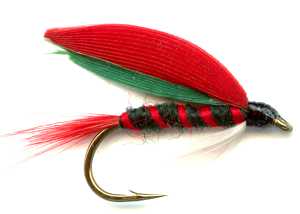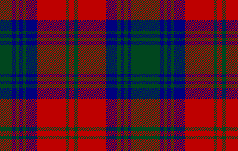TAR4. The Scottish Clan Lindsay
Single Hook Tartan Fly









TARTAN FLY PATTERNS OF SCOTLAND. Hook size 8 - $US each
Unlike most dry flies and nymphs, lure (streamer) flies do not try to represent a natural insect or bait fish. They are attractor flies that try to give the appearance of some thing that a trout may consider edible. I have found them successful when the fish do not seem to be taking an interest in their normal food. The appearance of this exotic looking fly seems to provoke a reflex attack reaction in some trout. This is particularly so if you can make you fly invade their 'space' as they are very territorial.







CLAN LINDSAY
Motto:Endure with strength
Main Colors: red, purple/navy and green
The name Lindsay originates from two sources. First from the name of the estate of the youngest of the de Toeny Brothers who as cousins, and hereditary standard-bearers of Normandy, who opposed William's succession to the Dukedom of Normandy. The oldest brother, Roger the Spaniard was killed in the fight but the rest of the family were still allowed to sail in the expedition to invade England in 1066. They also had a connection to the great territory of Lindsey in England south of the river Humber, where they held the manor of Forington. In early Anglo- Saxon times Lindsey had a dynasty of its own and its significant the Norman Lindsays took there name from the whole district and not their manor.
The line in Scotland appears to start with a Walter and a William. Both Knights and Barons on the Council of Prince David of Cumbria and Lothian (Scotland south of the Clyde and Forth). St. David brought these Anglo-Norman knights to Scotland. There they sat as Great Barons in the Scottish Councils or Parliaments from at least 1147. William and Walter were both barons of Ercildoun (now Earlstown).
Their descendents were Barons of Luffness and Crawford. One founded the barony of Lamberton in Berwickshire. They also held almost the entire Lake District in England. William Lindsay of Ercildoun married Marjory, daughter of Henry, Prince of Scotland, sister to William. the Lion. This branch married back into the Norman nobility, and Christiana de Lindsay married Ingelram de Gynes, The Sires de Councy. She was the ancestress of many Kings of France.







William Lindsay of this line was steward to the High Steward of Scotland. It was he who replaced the Norman eagle on the coat of arms with the check pattern of the Stewarts. Our chiefs have ever since acted as deputy for the Great Stewards of Scotland at coronations and investitures.
Sir Alexander Lindsay of Crawford (father was High Chamberlain) married sister of James, High Steward, who was descended from Somerled King of the Ilse. A later marriage to the Abernethy's brought more of Somerleds blood line to the Lindsay's through the MacDougall's and The Lords of Lorn. By the middle of the fourteenth century the Lindsay's were more than half Gael.
The Lindsay's supported Sir William Wallace and Robert The Bruce, forfeiting land in England for the Scottish cause. In the fight at Otterburn in 1388, there were Five Lindsay Knights present. Sir David Lindsay of Glenesk in 1390 was the best tourneyer champion of his time. As Champion of Scotland he fought a dual with Richard IIís champion, Lord Wells on London Bridge, nearly killing Wells. On this occasion the King referred to Lindsay as cousin.







After marrying a daughter of Robert II, he was made Earl of Crawford and High Admiral in 1398. They became the Premier Earls of Scotland, and as such, today carry the Scepter when the Honours of Scotland are brought out. The 'Tiger Earl' 4th of Crawford was in rebellion with the Black Douglas's and the MacDonald Chief, Lord of the Iles against James III. The plan was to split Scotland into three pieces for each to rule, as the Stewart King were becoming intolerable. Douglas was murdered by the King and MacDonald was not to be found when the Royal army showed up on Crawford's lands. The Crown was assisted by the Gordons. With little warning Crawford mounted a defense. He just barely lost, when a subordinate changed side. He was later restored to his lands His son, the 5th Earl of Crawford, became the Duke of Montrose. It was awarded by King James III. It was the first time that that a dukedom was given to Scotsman who was not of royal birth. The 5th Earl lost the title and the Crawford lands for supporting King James III against his rebellious son. later King James IV.
It passed to the Graham clan on his death in 1495. This Dukedom is still claimed by the Lindsay's. The Lindsay clan were engaged in bitter feuds with the clan Ogilvies and Alexanders. They remained loyal to the Stewart royal line. The 6th Earl died at the battle of Flodden in 1513. The 10th Earl Lindsay supported Mary Queen of Scots. The 16th Earl commanded a regiment for Charles I during the Civil War
The Lindsay's have held the Earldom of Crawford for over 600 years in an uninterrupted line. The senior Chieftain is the Earl of Lindsay and holds the Premier Lordship as Lord Lindsay of the Byres. The 20th Earl of Crawford raised the Black Watch. There have been four Lord Lyons of the Lindsay name. One, the famous Sir David Lindsay of the Mount, close friend and mentor to James V, was Scotland's first dramatist. In recent times the Lindsay have produced poets like Maurice Lindsay and a leading architect, Ian Lindsay. The Chiefs Have been involved in the arts and sciences, and leaders in government.







Tartan in Scotland
For many centuries tartan was the everyday dress of highland Scotland.
Although
it was worn in other parts of Scotland it was in the Scottish Highlands that
it
continued to be developed into a symbol of belonging to a particular clan. A
clan is like a tribe. Different areas of Scotland were controlled by
different
families.
Tartans used several centuries ago were very simple checks of two or three colours. These colours were obtained by using the dye from roots, plants, berries and trees.
When chemical dyes were invented a broader range of colours became available. More elaborate patterns were woven and branches of larger clans developed tartans of their own by adding an extra stripe or other variation of the main clan tartan pattern.
In the Royal Treasurer's accounts of 1471 there is a the first reference to the King of Scotland, James III, purchasing tartan. King James V wore tartan when out hunting in the Highlands in 1538. When Queen Elizabeth I of England died childless the Scottish King James VI of the Royal clan Stuart became King James I of England as well as Scotland. The English and Scottish King Charles II wore clan Stuart tartan ribbons on his coat at his marriage in 1662. In 1587 one of the first references to clan tartans was found in crown documents that show Hector MacLean of Duart paid the duties owed on his land not with money but with sixty bales of cloth of white, black and green. These colors are the colors of the MacLean hunting tartan.
Some Historians suggest that prior to the 18th century clansmen wore whatever pattern the weavers chose to supply, but in a recorded court case in 1572 a housewife won her case against a weaver who failed to supply her with the tartan cloth of the correct design. There are a number of literary references in the early 1700's to clansmen dressed in the livery of their chiefs. It is known that clans were organised on military lines, and that there were clan regiments. The tartan livery was the regimental uniform.







In 1688 the Stuart King James II was forced from the British throne because he was wanted to give greater freedoms to Catholic's. He was the first openly Catholic King since Henry VIII. In 1714 when the crown was offered to the Hanovarian King George I many people in Scotland were unhappy having a foreign ruler. They wanted a Stuart King on the British throne. Their hopes lay in the son of King James II, called James Stuart. His supporters were called 'Jacobites'. In 1715 the rebellion was easily put down and James fled to France. A greater threat to the British throne appeared in 1745. This invasion was lead by James Stuart's son, Charles Stuart, known as Bonnie Prince Charlie. With help from the French he landed on the Outer Hebrides. He then sailed to the Scottish mainland and marched southwards with a growing number of Highland clans. His followers were again called Jacobites. They captured Edinburgh and crossed into England. Few English joined the Jacobites. King George II sent a large army to oppose them. Bonnie Prince Charlie retreated to Scotland. In April 1746 the two armies meet at Culloden. The rebels lost and Bonnie Prince Charlie escaped to France. He had no children and he was the last Stuart to fight for the British throne. Because of the support of the Highland clans the British Government passed laws to stop any more Jacobite risings. These laws tried to destroy the clan system.
After the English victory at the battle of Culloden the London Government, in an attempt to purge the Highlands of all rebellious elements, passed an Act of Parliament disarming all Highlanders and made it unlawful to wear tartan. This was rigorously enforced and thus suggests that the clan tartan was worn with pride and as a sign of loyalty to their chief and the Stuart claim to the British throne rather than the German King Georges.
The act was repealed in 1785, but by that time the Highlanders had become accustomed to wearing other dress. Many of the tartan weavers had died taking details of the old styles with them to the grave. The first tartan revival occurred in 1822 when King George IV, whilst visiting Edinburgh, gave instructions that he desired local dignitaries to wear their clan tartan to royal functions. This resulted in new tartans being invented since those who had no clan tartan found tailors who could invent one for them.
Tartans are described by the purpose for which they are used
Clan Tartans: These are patterns for general use by members of the clan.
Dress Tartans: These were originally worn by the women of the clan and were lighter coloured variations of the clan tartan pattern.
Hunting Tartans: These were worn for sport. If a clan's tartan was brightly colored then their hunting tartan was designed using normally browns and greens so the wearer was less visible against the heather, grass and bracken of the moors and mountains.
Mourning Tartans: Dark variations on the clan tartan for use at funerals and during periods of mourning.
Chief's Tartans: These are special designs that are only worn by the clan chief and his immediate family.
Royal Tartans: These should never be worn by anyone outside the Royal family







To be sent regular information on flyfishing flies and news on special offers just click the British Royal Mail Post box
You can e-mail us at fly.fishing@blueyonder.co.uk
The English Fly Fishing Shop, Estate and Country Sports Equipment Ltd,
5 Woodland Way, Morden, Surrey SM4 4DS, England (Established 1978)